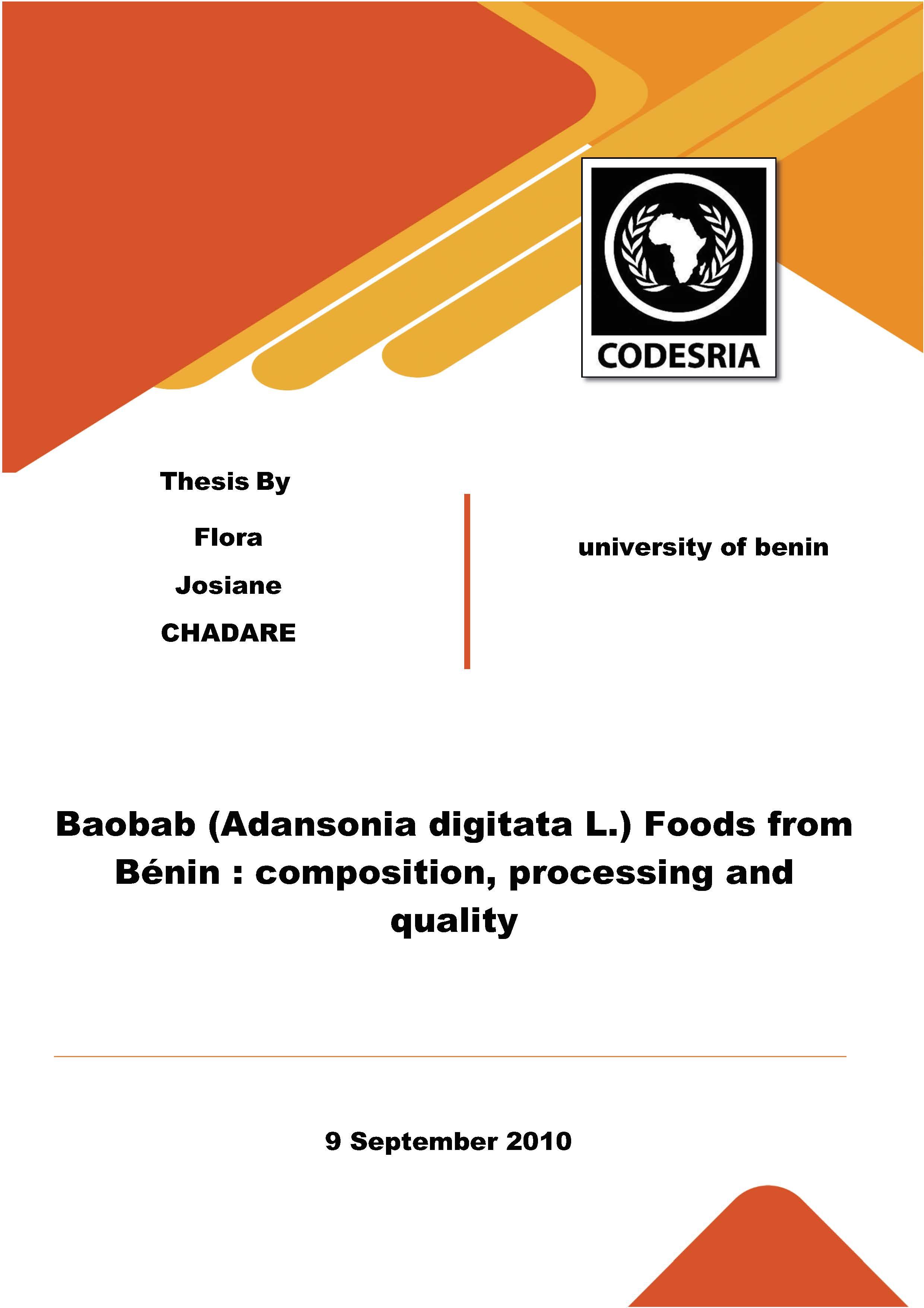Baobab (Adansonia digitata L.) Foods from Bénin : composition, processing and quality
Keywords:
Food, indigenous knowledg, forest products, nutrients, food, processing, Baobab, forest food, BeninSynopsis
In 2007, more than 923 million people did not have enough to eat (FAO, 2008), especially in developing countries. Simultaneously, several forest foods are available but under-utilized. Among them, the baobab tree (Adansonia digitata L.) is a key economic tree, a multipurpose, widely-used species, rich in nutrients in its leaves and fruits, used daily by local populations in several African countries for food, medicines and other purposes. The tree contributes significantly to nutrient supply in those areas where it grows. So far, few studies have been undertaken on the valorization of the species and on its contribution to food security in Africa. The present work focused on indigenous knowledge and nutritional aspects concerning baobab foods, necessary for further valorisation and improvement of local food processing practices. The objectives of the study were to (i) review the nutritional value of baobab parts, (ii) document ethno-food knowledge related to baobab food products in rural areas in Benin, (iii) assess the effect of traditional processing on in vitro digestibility and bioavailability of minerals and carotenoids in sauce made of baobab leaves, (iv) characterise the microbiological flora of baobab fermented food products and (v) build quantitative information on degradation of baobab pulp quality during storage. The review on baobab foods showed that pulp from baobab fruits is particularly rich in vitamin C (150 to 360 mg/100 g dw). The leaves are particularly rich in calcium (307 to 2640 mg/100 g dw). The whole seeds and the kernels have a relatively high lipid content, viz. 12 to 33 g/100 g dw and 19 to 35 g/100 g dw, respectively. The pulp and leaves exhibit antioxidant properties with a higher activity in the pulp than in the leaves. Two hundred and fifty-three processors of baobab food products were surveyed in Benin, to investigate the ethno-food knowledge related to baobab and the variation among socio-cultural groups. Local populations reported up to 35 baobab food products processed from the leaves, the pulp, the seeds and the kernels, most of which have never been characterized. Multivariate analysis showed that the types of foods processed from baobab differed among socio-cultural groups. The survey revealed that seed decortication is considered to be the most laborious processing operation and that the preservation of pulp and kernels is difficult in local conditions. The effect of processing on the quality of traditionally processed baobab leaves was evaluated. Assessment of in vitro digestibility and bioavailability of Ca, Fe, and Zn in non processed and processed baobab leaves showed that 10-30% of total Ca was available and that lutein and beta-carotene are the most important carotenoids. Moreover, “bitter leaves” are richer than “sweet leaves”, though the latter are the preferred ones. However, the experiments on Fe and Zn in vitro digestibility require further attention because of experimental difficulties caused by the sliminess of the leaves.
Downloads
References
Afolabi O.R. and Popoola T.O.S. (2005). The effects of baobab pulp powder on the micro flora involved in tempe fermentation. European Food Research and Technology 220 (2), 187- 190.
Agati V., Guyot J.P., Morlon-Guyot J., Talamond P. and Hounhouigan D.J. (1998). Isolation and characterization of new amylolytic strains of Lactobacillus fermentum from fermented maize doughs (mawe and ogi) from Benin. Journal of Applied Microbiology 85 (3), 512-520.
Ajayi L.A., Dawodu F.A. and Oderinde R.A. (2003). Fatty acid composition and metal content of Adansonia digitata seeds and seed oil. La Rivisita Italiana Delle Sosteanze Grasse 80, 41-43.
Assogbadjo A.E., Kyndt T., Sinsin B., Gheysen G. and Van Damme P. (2006). Patterns of genetic and morphometric diversity in baobab (Adansonia digitata) populations across different climatic zones of benin (West Africa). Annals of Botany 97, 819-830.
Assogbadjo A.E., Sinsin B., Codjia J.T.C. and Van Damme P. (2005). Ecological diversity and pulp, seeds and kernels production of the baobab (Adansonia digitata) in Benin. Belgian Journal of Botany 138 (1), 47-56.
Azokpota P., Hounhouigan D.J. and Nago M.C. (2006). Microbiological and chemical changes during the fermentation of African locust bean (Parkia biglobosa) to produce afitin, iru and sonru, three traditional condiments produced in Benin. International Journal of Food Microbiology 107, 304-309.
Azokpota P., Hounhouigan J.D., Annan N.T., Nago M.C. and Jakobsen M. (2008). Diversity of volatile compounds of afitin, iru and sonru, three fermented food condiments from Benin. World Journal of Microbiology and Biotechnology 24, 879-885.
Chadare F.J., Gayet D.P., Azokpota P., Nout M.J.R., Linnemann A.R., Hounhouigan J. and van Boekel M.A.J.S. (2010). Three undocumented fermented baobab foods from Benin: Mutchayan, Dikouanyouri and Tayohounta. Preparation, properties and consumption. Ecology of Food and Nutrition 49 (4), 1-19.
Chadare F.J., Hounhouigan J.D., Linnemann A.R., Nout M.J.R. and van Boekel M.A.J.S. (2008). Indigenous knowledge and processing of Adansonia digitata L. food products in Benin Ecology of Food and Nutrition. 47 (4), 338-362.
Codjia J.T.C., Fonton-Kiki B., Assogbadjo A.E. and Ekue M.R.M. (2001). Le baobab (Adansonia digitata), une espèce à usage multiple au Bénin, Coco Multimédia, Cotonou, 47p. Coleman W.H. and Setlow P. (2009). Analysis of damage due to moist heat treatment of spores of Bacillus subtilis.
Journal of Applied Microbiology 106 (5), 1600-1607.
Dakwa S., Sakyi-Dawson E., Diako C., Annan N.T. and Amoa-Awua W.K. (2005). Effect of boiling and roasting on the fermentation of soybeans into dawadawa (soy-dawadawa). International Journal of Food microbiology 104 (1), 69-82.
Fox K. and Eder D. (1969). Comparison of survivor curves of Bacillus subtilis spores subjected to wet and dry heat. Journal of Food Science and Technology India 34 (6), 518-521. Furukawa S., Narisawa N., Watanabe T., Kawarai T., Myozen K., Okazaki S., Ogihara H. and Yamasaki M. (2005). Formation of the spore clumps during heat treatment increases eat resistance of bacterial spores. International Journal of Food Microbiology 102 (1), 107-111.






